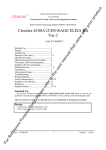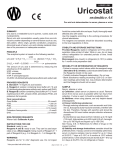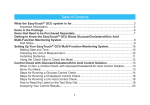Download Uric Acid/Uricase Assay Kit
Transcript
Product Manual Uric Acid/Uricase Assay Kit Catalog Number STA-375 400 assays FOR RESEARCH USE ONLY Not for use in diagnostic procedures Introduction For humans and higher primates, uric acid is the final oxidation end product of purine nucleotide metabolism. The enzyme xanthine oxidase makes uric acid from xanthine and hypoxanthine, which are derived from purines. Although most animals can metabolize uric acid to the easily excreted product allantoin, humans lack the necessary enzyme, urate oxidase (uricase), due to two nonsense mutations in the uricase gene. Uric acid is released in hypoxic conditions and is usually excreted in the urine via glomerular filtration. Approximately 70% of daily uric acid disposal occurs via the kidneys. Like ascorbic acid, uric acid is a strong reducing agent (electron donor) and a potent antioxidant. In humans, over half of the antioxidant capacity of blood plasma is derived from uric acid. High levels of uric acid have been linked to impaired renal function, polycythemia, leukemia, as well as consumption of foods high in nucleoproteins. Genetic and acquired influences, such as obesity and alcohol consumption, influence uric acid concentrations. Hyperuricemia induces or accelerates the development of gout, kidney stones, hypertension, metabolic syndrome, and renal and cardiovascular disease. Within 525% of humans, impaired renal (kidney) excretion leads to hyperuricemia. Gout is an inflammatory condition that results from uric acid deposits within the body joints. Exercise induced acute renal failure or impairment is a major complication related to hypouricemia. Cell Biolabs’ Uric Acid/Uricase Assay Kit is a simple HTS-compatible assay for measuring uric acid concentrations in biological samples such as serum, plasma, and urine without any need for pretreatment. The kit has detection sensitivity limit of 0.5 µM of uric acid or 1 mU/mL uricase. Each kit provides sufficient reagents to perform up to 400 assays, including standard curve and unknown samples. Assay Principle The Uric Acid/Uricase Assay Kit is a sensitive quantitative fluorometric assay for measuring uric acid or uricase concentrations. Uric acid reacts with water and oxygen in the presence of the enzyme uricase to produce allantoin and H2O2. In the presence of HRP, a Fluorescence Probe reacts with H2O2 in a 1:1 stoichiometry to produce a highly fluorescent product. This fluorescent product can be easily read by a fluorescence microplate reader with an excitation of 530-560 nm and an emission of 590 nm. Fluorescence values are proportional to the uric acid or uricase levels within the samples, depending on which compound is being measured. The uric acid or uricase content in unknown samples is determined by comparison with its respective standard curve (Figure 1). 2 Figure 1. Uric Acid Assay Principle. Related Products 1. STA-320: OxiSelect™ Oxidative DNA Damage ELISA Kit (8-OHdG Quantitation) 2. STA-340: OxiSelect™ Superoxide Dismutase Activity Assay Kit 3. STA-342: OxiSelect™ Intracellular ROS Assay Kit (Green Fluorescence) 4. STA-344: OxiSelect™ Hydrogen peroxide/Peroxidase Assay Kit (Fluorometric) 5. STA-345: OxiSelect™ ORAC Activity Assay 6. STA-347: OxiSelect™ In Vitro ROS/RNS Assay Kit (Green Fluorescence) 7. STA-360: OxiSelect™ Total Antioxidant Capacity (TAC) Assay Kit 8. STA-374: OxiSelect™ Human KIM-1 ELISA Kit 9. STA-378: Creatinine Assay Kit 3 Kit Components Box 1 (shipped at room temperature) 1. Uric Acid Standard (Part No. 236001): One 100 mg tube of powder. 2. Fluorescence Probe (Part No. 237502): One 200 μL amber tube of a 10 mM solution in DMSO. 3. HRP (Part No. 234402): One 100 μL tube of 100 U/mL solution in glycerol. 4. 10X Assay Buffer (Part No. 234403): One 25 mL bottle. Box 2 (shipped on blue ice packs) 1. Uricase (Part No. 237503): One 80 μL amber tube of 100 U/mL**. *Note: One unit is defined as the amount of enzyme that will oxidize 1.0 μmole of uric acid to allantoin per minute at pH 8.5 and 25ºC. Materials Not Supplied 1. 1N NaOH and deionized water 2. 100 mM Tris, pH 7.5 3. 1X PBS for sample dilutions and controls as necessary 4. 10 μL to 1000 μL adjustable single channel micropipettes with disposable tips 5. 50 μL to 300 μL adjustable multichannel micropipette with disposable tips 6. Standard 96-well fluorescence black microtiter plates 7. Multichannel micropipette reservoir 8. Fluorescence microplate reader capable of reading excitation in the 530-570 nm range and emission in the 590-600 nm range. Storage Upon receipt, aliquot and store the Fluorescence Probe, HRP, and Uricase at -20ºC. The Fluorescence Probe is light sensitive and must be stored accordingly. Avoid multiple freeze/thaw cycles. Store the remaining kit components at room temperature. Preparation of Reagents Note: All reagents must be brought to room temperature prior to use. • 1X Assay Buffer: Warm the 10X Assay Buffer to room temperature prior to using. Prepare a 1X Assay Buffer by diluting the 10X Assay Buffer with deionized water. Add 25 mL 10X Assay Buffer to 225 mL deionized water for 250 mL total. Mix to homogeneity. Store the 1X Assay Buffer at 4ºC up to 12 months. • Uric Acid Working Reagent (Uric Acid Assay): If measuring uric acid, prepare a Uric Acid Working Reagent by diluting the Fluorescence Probe 1:100, HRP 1:250, and Uricase 1:250 in 1X 4 Assay Buffer (e.g. For 100 assays, combine 50 µL of Fluorescence Probe, 20 µL HRP, and 20 µL Uricase with 1X Assay Buffer to a 5 mL total volume). Mix thoroughly and protect the solution from light. For best results, use the Uric Acid Working Reagent within 30 minutes of preparation. Prepare only enough for immediate use. Do not store the Working Reagent solution. • Uricase Working Reagent (Uricase Assay): Prior to measuring uricase activity, weigh out the Uric Acid Standard powder for a 10 mg/mL solution in 1N NaOH*. This 10 mg/mL is equivalent to a concentration of 60 mM. Once dissolved, dilute the 60 mM uric acid solution to a concentration of 10 mM in 100 mM Tris, pH 7.5. Vortex thoroughly. Next, prepare the Uricase Working Reagent by diluting the Fluorescence Probe 1:100, HRP 1:250, and uric acid solution 1:10 in 1X Assay Buffer (e.g. for 100 assays, combine 50 µL of Fluorescence Probe, 20 µL HRP, and 500 µL Uric Acid with 1X Assay Buffer to a 5 mL total volume). Mix thoroughly and protect the solution from light. For best results, use the Uricase Working Reagent within 30 minutes of preparation. Prepare only enough for immediate use. Do not store the Working Reagent solution. *Note: If uric acid solution has visible precipitation, or does not readily go into solution, warm the solution at 37ºC and vortex thoroughly to resuspend and dissolve. Preparation of Samples • • • • • Cell Culture Supernatant: To remove insoluble particles, centrifuge at 10,000 rpm for 5 min. The supernatant can be assayed directly or diluted as necessary. Prepare the standard curve in the same non-conditioned media. Note: Maintain pH between 7 and 8 for optimal working conditions as the Fluorescent Probe is unstable at high pH (>8.5). Cell Lysate: Resuspend cells at 1-2 x 106 cells/mL in 1X Assay Buffer or PBS. Homogenize or sonicate the cells on ice. Centrifuge to remove debris. Cell lysates can be assayed undiluted or titrated as necessary. Serum: Collect blood without using an anticoagulant and allow to clot for 30 minutes at 25ºC. Centrifuge at 2000 x g and 4ºC for 15 minutes. Remove the serum layer and store on ice. Avoid disturbing the white buffy layer. Aliquot samples for testing and store at -80ºC. Perform dilutions in 1X Assay Buffer or PBS. Plasma: Collect blood with heparin or citrate and centrifuge at 500-1000 x g and 4ºC for 10 minutes. Remove the plasma layer and store on ice. Avoid disturbing the white buffy layer. Aliquot samples for testing and store at -80ºC. Perform dilutions in 1X Assay Buffer or PBS. Urine: To remove insoluble particles, centrifuge at 10,000 rpm for 5 min. The supernatant can be assayed directly or diluted as necessary. Dilute in 1X Assay Buffer or PBS. Aliquot samples for testing and store at -80ºC. Notes: • All samples should be assayed immediately or stored at -80°C for up to 1-2 months. Run proper controls as necessary. Optimal dilution conditions for samples must be determined by the investigator. Always run a standard curve with samples. • Samples with NADH concentrations above 10 μM and glutathione concentrations above 50 μM will oxidize the probe and could result in erroneous readings. To minimize this interference, it is recommended that superoxide dismutase (SOD) be added to the reaction at a final concentration of 40 U/mL (Tayana et al, Ref. 2). 5 • • Avoid samples containing DTT or β-mercaptoethanol since the probe is not stable in the presense of thiols (above 10 μM). Uric acid values from urine can be normalized to creatinine levels. Preparation of Standard Curves • Uric Acid Standards: Prepare fresh Uric Acid standards by weighing out the Uric Acid Standard powder for a 10 mg/mL solution in 1N NaOH*. This 10 mg/mL is equivalent to a concentration of 60 mM. Use the 60 mM Uric Acid solution to prepare a 1 mM solution of Uric Acid (eg. add 50 µL of the 60 mM Uric Acid standard to 2.950 mL of 1X Assay Buffer). Use the 1 mM solution to prepare a series of uric acid standards according to Table 1 below. Prepare only enough for immediate use. Do not store the Working Reagent solution. *Note: If uric acid solution has visible precipitation, or does not readily go into solution, warm the solution at 37ºC and vortex thoroughly to resuspend and dissolve. Standard Tubes 1 2 3 4 5 6 7 8 1 mM Uric Acid Standard (µL) 50 500 of Tube #1 500 of Tube #2 500 of Tube #3 500 of Tube #4 500 of Tube #5 500 of Tube #6 0 1X Assay Buffer (µL) 950 500 500 500 500 500 500 500 Uric Acid (µM) 50 25 12.5 6.25 3.125 1.56 0.78 0 Table 1. Preparation of Uric Acid Standards • Uricase Standard: Prepare fresh uricase standards by first diluting the 100 U/mL solution to 1 U/mL in 1X Assay Buffer. Vortex thoroughly. Prepare a series of the remaining uricase standards according to Table 2 below. Prepare only enough for immediate use. 6 Standard Tubes 1 2 3 4 5 6 7 8 1 U/mL Uricase Standard (µL) 100 500 of Tube #1 500 of Tube #2 500 of Tube #3 500 of Tube #4 500 of Tube #5 500 of Tube #6 0 1X Assay Buffer (µL) 900 500 500 500 500 500 500 500 Uricase (mU/mL) 100 50 25 12.5 6.25 3.13 1.56 0 Table 2. Preparation of Uricase Standards Assay Protocol I. Uric Acid 1. Prepare and mix all reagents thoroughly before use. Each sample, including unknowns and standards, should be assayed in duplicate or triplicate. 2. Add 50 µL of each sample (uric acid standards, hydrogen peroxide controls or unknowns) into an individual microtiter plate well. 3. Add 50 µL of Uric Acid Working Reagent to each well. Mix the well contents thoroughly and incubate for 20 minutes at 37ºC and protected from light. Note: This assay is continuous (not terminated) and therefore may be measured at multiple time points to follow the kinetics of the reactions. 4. Read the plate with a fluorescence microplate reader equipped for excitation in the 530-570 nm range and for emission in the 590-600 nm range. 5. Calculate the concentration of uric acid within samples by comparing the sample RFUs to the uric acid standard curve. Subtract the value from the zero uric acid control well. II. Uricase 1. Prepare and mix all reagents thoroughly before use. Each sample, including unknowns and standards, should be assayed in duplicate or triplicate. 2. Add 50 µL of each sample (uricase standards, hydrogen peroxide controls or unknowns) into an individual microtiter plate well. 3. Add 50 µL of Uricase Working Reagent to each well. Mix the well contents thoroughly and incubate for 60 minutes at 37ºC and protected from light. Note: This assay is continuous (not terminated) and therefore may be measured at multiple time points to follow the kinetics of the reactions. 4. Read the plate with a fluorescence microplate reader equipped for excitation in the 530-570 nm range and for emission in the 590-600 nm range. 5. Calculate the concentration of uricase within samples by comparing the sample RFUs to the uricase standard curve. Subtract the value from the zero uricase control well. 7 Example of Results The following figures demonstrate typical Uric Acid/Uricase Assay results. One should use the data below for reference only. This data should not be used to interpret actual results. Figure 2. Uric Acid Standard Curve. Figure 3. Uricase Standard Curve. References 1. Heinig, M. and Johnson, R.J. Cleve. Clin. J. Med. (2006) 73(12): 1059-1064. 2. Tatyana, V., et al. Neurochem. (2001) 79: 266. 3. Ichida, K., et al. Genome Med. (2009) 1(12): 118. 4. Mahler, H.R., et al. J. Biol. Chem. (1955) 216: 625-641. 5. Watanabe, S., et al. Hypertension. (2002) 40: 355-360. 8 Recent product citation Leiba, A. et al. (2015). Uric acid levels within the normal range predict increased risk of hypertensiona cohort study. Am J Hypertens American. doi:10.1016/j.jash.2015.05.010. Warranty These products are warranted to perform as described in their labeling and in Cell Biolabs literature when used in accordance with their instructions. THERE ARE NO WARRANTIES THAT EXTEND BEYOND THIS EXPRESSED WARRANTY AND CELL BIOLABS DISCLAIMS ANY IMPLIED WARRANTY OF MERCHANTABILITY OR WARRANTY OF FITNESS FOR PARTICULAR PURPOSE. CELL BIOLABS’ sole obligation and purchaser’s exclusive remedy for breach of this warranty shall be, at the option of CELL BIOLABS, to repair or replace the products. In no event shall CELL BIOLABS be liable for any proximate, incidental or consequential damages in connection with the products. Contact Information Cell Biolabs, Inc. 7758 Arjons Drive San Diego, CA 92126 Worldwide: +1 858-271-6500 USA Toll-Free: 1-888-CBL-0505 E-mail: [email protected] www.cellbiolabs.com 2012-2015: Cell Biolabs, Inc. - All rights reserved. No part of these works may be reproduced in any form without permissions in writing. 9















